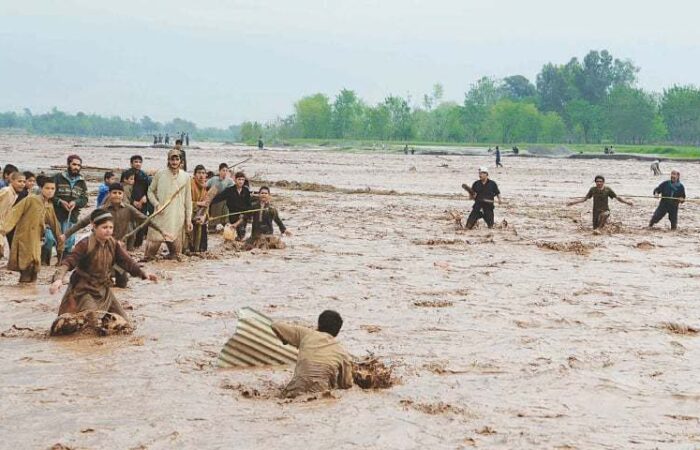Written by Zainab Chishti
Situated between the peaks of the Himalayas and the vast Arabian Sea, Pakistan is an enchanting land with rich cultural heritage. Well known for its diverse ecosystems, with landscapes ranging from cold mountain tops to the extreme barren deserts.
But, in recent years, the country has experienced an array of environmental challenges that have intensified. This has left communities vulnerable and ecosystems on the brink of collapse.
This blog sheds some light on the recent impacts of climate change in Pakistan. How severe and alarming really is the situation in this country?
Melting Glaciers
Melting too fast
The northern regions of Pakistan are home to vast glaciers that are a crucial source of freshwater for the country’s rivers. But, due to global warming, these glaciers are melting at a rapid rate.
The Hindu Kush Himalayan region, where many of the glaciers are located, is particularly vulnerable to climate change.
The melting ice contributes to increased river flows in the short term, but also poses long term risks. These water sources may dry up, leading to water shortage for both drinking and agricultural purposes.
Melting too slow
“In Skardu, there is a water shortage because the glaciers are not melting in the summer. It seems it is too cold at the peak, but too warm in the valley. People had to use water sparingly”
Bushra Javed
AFP
We also discovered recently through conversation with a visiting local, Bushra Javed, Member of Adventure Foundation Pakistan (AFP) that Skardu is facing severe water scarcity as the water level in Sadpara Dam has fallen to a dead level.
Ironically, “what is happening here is that the glacier is not melting at the top of the mountain”, she claims. The current environment sounds like that of Cape Town’s day zero in 2018.
Locals have complained about power outages of up to 22 hours and no supply of drinking water for 20 hours.
Usually, the dam receives enough water from the melting glaciers to fulfil the needs of the locals. However, this summer, the water flow from the glaciers reduced considerably and was irregular.
Escalating Temperatures and Heatwaves
Pakistan has seen a significant rise in the temperatures over the past few decades. According to Pakistan Meteorological Department (PMD) data, the average annual temperature has increased by approximately 0.5°C per decade since the 1960s.
This warming trend has resulted in more frequent and intense heat waves. One of the deadliest had struck Southern Pakistan in May 2022, with temperatures rising as high as 51°C (120°F) in Jaccobabad. Naming the city the hottest in the world.
This heat wave claimed the lives of over 1,200 people, mainly affecting the vulnerable populations like the elderly and labourers working outdoors.
It was also recorded that 2022 was the 5th warmest year in Pakistan. The average annual temperature in the country was 0.84°C above the 1961-1990 average.
Rising Sea Levels

Pakistan’s coastal areas, such as Karachi, Gwadar and the Indus Delta, are at risk due to the rising sea levels. Predicted by the Intergovernmental Panel on Climate Change (IPCC), the sea levels could rise up by 1 metre by the end of the century.
This threatens about 5.2 million people living in the low-lying coastal areas of Pakistan. Homes, infrastructure, and agricultural lands are at risk of being washed away, displacing these communities and disrupting their livelihoods.
Coastal erosion and saltwater intrusion have already begun to impact freshwater sources. As sea levels rise, saltwater can intrude into freshwater sources, such as rivers and underground aquifers.
The intrusion contaminates drinking water supplies, making it unusable. This is disrupting agricultural activities while also threatening water security and creating public health risks.
Impact on Agriculture
Pakistan’s main source of income is through its agriculture. It not only contributes to the GDP but also employs millions of people. However, in recent times, agricultural productivity is facing major challenges due to climate change. Issues such as water scarcity, changing precipitation patterns and pest infestations, have increased.
It is reported by the Asian Development Bank that agricultural yield may decrease by up to 8% by 2050 due to climate change in Pakistan. This puts immense pressure on food security, increasing poverty in the rural areas.
Threats to Biodiversity
Our country is blessed with a diverse range of ecosystems. From the unique mangroves of the Indus Delta to the high-altitude biodiversity hotspots of the northern regions. But, climate change in Pakistan is posing significant threats to this delicate balance.
The forests are under pressure due to deforestation, contributing to carbon emissions. The loss of habitat and changing climatic conditions have threatened several species such as the snow leopard and several other bird species. Even the national animal of Pakistan, the Markhor, is endangered.
Increasing Frequency of Extreme Weather Events

Unfortunately, climate change in Pakistan has intensified the extreme weather events. This includes droughts, cyclones and floods. These events have had devastating impacts on communities, infrastructure and the economy.
In 2022, the country witnessed the highest and record breaking rainfall during monsoon. The national rainfall was 77% above the 1960 – 2010 average according to Pakistan Meteorological Department
The recent floods in 2022 have been the second most deadliest in the country. It has affected around 33 million people while killing around 1700. The flooding has caused $14.9 billion in damages and $15.2 billion in economic losses.
Each year, there is a cyclone warning in coastal areas of Pakistan. There have been about 9 storms that have struck these areas since the 2000s. The country is still under the threat of many heavy rainfalls, floods and thunderstorms in the coming days.
Health Implications and Diseases
Climate change in Pakistan is directly linked to public health issues. The recent floods have led to an increase in stagnant water across the country.
As a result, there has been a surge in malaria and dengue. Clean water has also been unavailable for many communities, forcing them to drink dirty and unhygienic water, leading to many diseases like typhoid or cholera among the children and adults.
This impacts the public health systems, putting pressure on the already strained hospitals and its healthcare resources.
In Conclusion
Pakistan is among the 8 countries that have been most affected by climate change. These impacts have led to a trail of destruction throughout the whole nation.
Escalating temperatures, melting glaciers, rising sea levels, extreme weather events, biodiversity loss, and threats to agriculture and public health are the realities that demand immediate action.
Addressing this issue requires united efforts from both the government and its citizens, meaning us. We must commit to adopting sustainable practices in Pakistan and mitigating greenhouse gas emissions. Spreading environmental education in Pakistan is also another crucial step to build climate resilience in Pakistan.
There are a number of Pakistan climate initiatives that are popping up in the country that should be given immense support.
Our generation holds the key to overcoming the environmental challenges posed by climate change in Pakistan, done only through collective action. Let’s come together and secure a bright future for our beautiful country!
Raising Environmental Awareness in Pakistan?
Do you want to increase environmental awareness or be part of a bigger solution?
Find Out How



This is very well written and is really informative!
Beautifully written and explained. Love it! 👍🏼👍🏼
Very enlightening. People aren’t aware of such issues and this blog spreads awareness of these problems.
It’s beautifully written and an eye opener about what’s actually happening here.
Such a thorough explanation!! Loved it
Very well written!